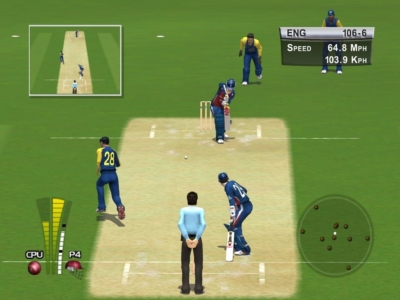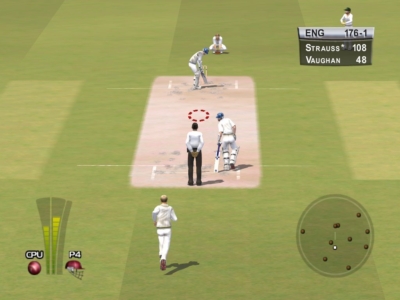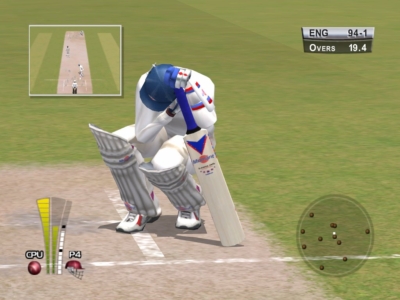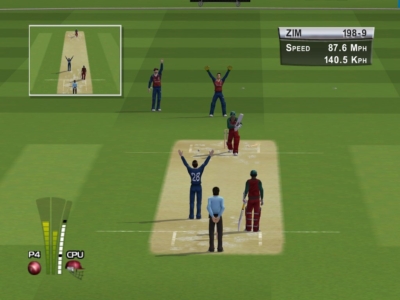
Brian Lara International Cricket 2005
Written by: Rik
Date posted: January 17, 2011
- Genre: Sport
- Developed by: Codemasters
- Published by: Codemasters
- Year released: 2005
- Our score: 7
Having played pretty much every single one of them, I can say with some certainty that there has never been a good cricket game. And when I say ‘good’, I mean that, ideally, a sports title should meet the following criteria: it should competently and authentically reproduce the real-life game in such a form that it can be easily digested and enjoyed by someone with a moderate knowledge of both gaming and the sport itself. In other words, something along the lines of FIFA and Pro Evo: they’re like football, but games only last 10 minutes rather than 90, and while the well-practised will always have an advantage, anyone who’s played games and knows about football shouldn’t have any trouble.
At the time of writing, we’re not there with cricket, not even close. In truth, it’s probably never going to happen. For one thing, it’s a pretty tricky task to boil down all the intricacies and subtleties of this greatest (in my opinion) of all sports into an easily digestible package that’ll suit both the casual and the hardcore cricket fan. And for another, there’s absolutely no need to go to the trouble, because the latter group are all so desperate for something good that we’ll run out and buy the latest title anyway. Sure, there are demos, and the reviews written by people who either don’t like or don’t understand cricket, not to mention the stacks of previous disappointments sitting on our shelves, but it’s always too much to resist: the chance that this one just might be the one. Of course, it never is.
So, we’ve had to lower our standards a bit. In fact, given the grimly unenjoyable nature of most of the efforts churned out over the years, anything that proves to be even vaguely playable represents a nice change from the norm. Enter Brian Lara International Cricket 2005, a game with myriad faults that mean it falls some way short of the ideal cricket simulation, yet somehow remaining playable enough to while away a few hours without being consumed by a passionate desire to break something. (Most of those faults, by the way, are kind of cricket-y, so I’ve listed them separately in case you’re not interested, and also so I don’t get too distracted by the generally positive tone I’m trying to maintain here).
Onto the game itself, then, and as you might expect, before you get started, you need to select the particular flavour of cricket you want to, er, taste. You can play one-off limited-overs or Test matches, or opt for a longer tournament or a Test series. If you decide to plump for one of the two ICC-sanctioned one-day tournaments available in the game (either the 2003 World Cup in South Africa or the 2004 Champions’ Trophy in England) you’ll be presented with accurate squads with which to do battle. If not, you’ll get misspelled names, plain kits and generic likenesses. It’s annoying, certainly, but the overall effect is mitigated by the general cartooniness of the game’s graphical approach which does a fairly good job of botching the supposedly accurate representations during the licensed tournaments anyway. If the names bother you, there’s the option to change them all manually, if you really have the time to do that kind of thing, but there’s no detailed stats to speak of: no averages, career history, nothing – just a rating for batting, bowling and fielding (which you can’t change).
That might sound like a serious omission, but I know from bitter previous experience that endless editing and statistics screens are nothing but a clever diversion. The developers know that no serious cricket fan will be able to resist altering slightly-outdated or inaccurate squad lists, perhaps even before they’ve started playing the game. Take my advice, sportsfans: time spent tinkering and fiddling with menus is always better spent finding out whether the game is actually going to be worth playing or not. If it is, then you can do all of that later; if not, well, you just saved a few precious hours of your life.
Out on the pitch, depending on the outcome of the always-important toss of a coin, you’ll be either batting or bowling. Dealing with batting first, the control scheme is fairly easy to get to grips with: you simply choose the intended direction of your shot with the direction pad, and then press one of three buttons (defensive, attacking, lofted) to execute it. Shot selection and timing are the main things to get right, and by doing so you build up your batsman’s ‘confidence meter’, which in turn makes it easier to time your shots. Missing or mistiming the ball, or getting hit on the body, though, reduces confidence.
The basic principle of being cautious at first and more aggressive once you’ve played yourself in is pretty sound, and though this isn’t the first time such a feature has been implemented, it is the first time it’s been done well. By and large, the meter does reflect how secure your batsman is at the crease, and when confidence is low and wickets are falling, you do genuinely feel inclined to play more circumspectly. While this is happening, incidentally, the bowler’s confidence meter is likely to be pretty close to the top, making him more likely to bowl well, and even unleash one or two surprise deliveries to catch you off guard. Negotiate these tricky periods, though, and you’ll find you’ll eventually be able to dominate, smashing the ball to all parts.
Bowling has traditionally been a cricket game’s Achilles heel: while there’s a modicum of enjoyment to be gleaned from even the most flawed title by putting a few runs together and building a total, bowling tends to be on the dull side, plodding in again and again more in hope than expectation. One of the main reasons it tends to be boring is because most of the challenge in actually delivering the ball is taken away, with the game allowing you to plop the ball wherever you want on the pitch with the minimum of fuss. Another major factor is the lack of variety provided by your bowling attack. Fast or medium-fast bowling, which generally forms between 60 and 100% of most real-life international teams’ bowling line-ups, has always been disappointingly one-dimensional when represented in cricket games, offering no opportunity for lateral movement, and often with the same animation being used for all bowlers, making bowling a repetitive chore in most instances.
Here, though, there’s plenty of variety. Fast bowlers can move the ball off the pitch or through the air and vary their approach angle and pace, and there’s also a handful of different animations for fast bowlers which means that for once you do actually feel like you’re changing the bowling rather than having a set of identikit robot bowlers at your disposal. While the game does still allow you to pick the spot you want to bowl at with some degree of accuracy, it’s not quite as easy to control as some games, and there’s more scope here for trying new things so you rarely feel like you’re just bowling in the same place all day long. As with batting, each bowler has a confidence meter that can be built up through dot-balls, hitting the batsman on the body and, of course, wickets. On full confidence, you can produce a special delivery, which will do something cunning at the last-minute to fox the batsman – either moving where the ball will pitch (for fast bowlers) or spinning the opposite way to the one indicated (spinners). To be honest, these don’t seem to outfox the AI batsmen too often, but they can be pretty challenging to face when you’re on the receiving end.
You also have some control over the fielders – although you don’t have to direct them to the ball, you do select the strength of their return to the wicketkeeper with a power-bar that appears each time your fielder picks the ball up. Basically, you need to hit the middle of the meter for an ‘ideal’ throw. If the ball has been hit in the air, then this same meter will appear in order for you to take a catch. To be honest, it’s not the most interactive system in the world, but then I’d argue that you don’t really want to be doing all of the fielding yourself anyway. At the same time, fielding is a significant part of the real-life game so for it to be totally automated might not be appropriate either. This is a good way of keeping you involved without having to actually do too much.
Perhaps the best thing to say about the whole package is that it zips along quite nicely, which is a good general approach when you consider how long it takes actual cricket matches to play out. A simple push of a button terminates any extraneous animations smoothly and instantaneously, allowing you to get on with the next delivery with the minimum of fuss, and it’s amazing how much play you can actually fit into a relatively short period of time. No longer is a full-length 50-over match an entire afternoon’s undertaking: here you could be done in a couple of hours. By the same token, a tournament or a test series is suddenly a more realistic prospect than ever before. A cricket game that you can actually be bothered to play – who’d have thought it?
As I mentioned though, there are problems. Those more likely to specifically annoy cricket lovers have been boxed away already, but in more general terms, the first thing you’d have to say is that the whole thing is a little on the easy side. When batting you can score pretty quickly, aided by some fairly odd decisions by the fielding captain, while it’s also much too easy to restrict the opposition when you’re bowling. If you’re happy to drift along with the default field settings and bowl a variety of deliveries then the AI puts up a decent fight, but if you’re more tenacious than that then your opponents can be dismissed for some fairly low scores. And while your own lower-order batsmen are able to slog the ball for miles, despite their range of shots being limited (another nice touch), it seems all you have to do to dismiss the opposition tailenders is to bowl a straight one.
Secondly, even though the bowling is much more engaging than in other cricket games, in the five-day Test matches it still tends to be a bit of a drag. In fact, Test matches in general fall a little short of the ideal levels of excitement, and no matter how much you might prefer the longer form of the game (as I do), it’s hard to avoid the conclusion that one-day cricket is more satisfyingly realised here. Finally, while it’s good that the game moves quickly, it’s all a little too quick for the commentary, which is a bizarrely considered affair, with those involved mainly ignoring the events on the pitch in favour of vaguely-topical discussion about the modern game or wistful reminiscences about past greats. Considering the wealth of commentary talent (Agnew, Gower, Bishop, Grieg and Lawry) employed to undertake these duties, it all seems a bit of a waste, as much of what they say is cut off before they’ve even started.
So, it’s not perfect, then – in fact, the phrases ‘very good’ and ‘excellent’ might still be a little too effusive – but it is playable, and despite its flaws it does seem to operate according to some kind of reasonable internal logic that won’t have you shouting “Well, why the hell did that happen?” at the screen. And when you consider the whole sorry history of the genre, particularly the on-rails frustration of the execrable EA Cricket series, that’s quite an achievement.






 Posts
Posts